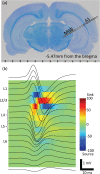Vagus nerve stimulation (VNS)-induced layer-specific modulation of evoked responses in the sensory cortex of rats
- PMID: 32488047
- PMCID: PMC7265555
- DOI: 10.1038/s41598-020-65745-z
Vagus nerve stimulation (VNS)-induced layer-specific modulation of evoked responses in the sensory cortex of rats
Abstract
Neuromodulation achieved by vagus nerve stimulation (VNS) induces various neuropsychiatric effects whose underlying mechanisms of action remain poorly understood. Innervation of neuromodulators and a microcircuit structure in the cerebral cortex informed the hypothesis that VNS exerts layer-specific modulation in the sensory cortex and alters the balance between feedforward and feedback pathways. To test this hypothesis, we characterized laminar profiles of auditory-evoked potentials (AEPs) in the primary auditory cortex (A1) of anesthetized rats with an array of microelectrodes and investigated the effects of VNS on AEPs and stimulus specific adaptation (SSA). VNS predominantly increased the amplitudes of AEPs in superficial layers, but this effect diminished with depth. In addition, VNS exerted a stronger modulation of the neural responses to repeated stimuli than to deviant stimuli, resulting in decreased SSA across all layers of the A1. These results may provide new insights that the VNS-induced neuropsychiatric effects may be attributable to a sensory gain mechanism: VNS strengthens the ascending input in the sensory cortex and creates an imbalance in the strength of activities between superficial and deep cortical layers, where the feedfoward and feedback pathways predominantly originate, respectively.
Conflict of interest statement
The authors declare no competing interests.
Figures




Similar articles
-
Vagus nerve stimulation as a predictive coding modulator that enhances feedforward over feedback transmission.Front Neural Circuits. 2025 Apr 14;19:1568655. doi: 10.3389/fncir.2025.1568655. eCollection 2025. Front Neural Circuits. 2025. PMID: 40297016 Free PMC article. Review.
-
Frequency-specific modulation of oscillatory activity in the rat auditory cortex by vagus nerve stimulation.Brain Stimul. 2023 Sep-Oct;16(5):1476-1485. doi: 10.1016/j.brs.2023.09.019. Epub 2023 Sep 29. Brain Stimul. 2023. PMID: 37777110
-
Effect of vagus nerve stimulation on neural adaptation in thalamo-cortical system in rats.Annu Int Conf IEEE Eng Med Biol Soc. 2016 Aug;2016:1834-1837. doi: 10.1109/EMBC.2016.7591076. Annu Int Conf IEEE Eng Med Biol Soc. 2016. PMID: 28268683
-
The interaction of pulse width and current intensity on the extent of cortical plasticity evoked by vagus nerve stimulation.Brain Stimul. 2018 Mar-Apr;11(2):271-277. doi: 10.1016/j.brs.2017.11.007. Epub 2017 Nov 15. Brain Stimul. 2018. PMID: 29174302 Free PMC article.
-
Directing neural plasticity to understand and treat tinnitus.Hear Res. 2013 Jan;295:58-66. doi: 10.1016/j.heares.2012.10.001. Epub 2012 Oct 23. Hear Res. 2013. PMID: 23099209 Review.
Cited by
-
Auditory, Visual, and Cross-Modal Mismatch Negativities in the Rat Auditory and Visual Cortices.Front Hum Neurosci. 2021 Sep 17;15:721476. doi: 10.3389/fnhum.2021.721476. eCollection 2021. Front Hum Neurosci. 2021. PMID: 34602996 Free PMC article.
-
Neuroprosthetics in systems neuroscience and medicine.Sci Rep. 2021 Mar 8;11(1):5404. doi: 10.1038/s41598-021-85134-4. Sci Rep. 2021. PMID: 33686138 Free PMC article.
-
Vagus nerve stimulation modulates information representation of sustained activity in layer specific manner in the rat auditory cortex.Front Neural Circuits. 2025 Jul 23;19:1569158. doi: 10.3389/fncir.2025.1569158. eCollection 2025. Front Neural Circuits. 2025. PMID: 40771876 Free PMC article.
-
Noninvasive Brain Stimulation for Neurorehabilitation in Post-Stroke Patients.Brain Sci. 2023 Mar 6;13(3):451. doi: 10.3390/brainsci13030451. Brain Sci. 2023. PMID: 36979261 Free PMC article. Review.
-
Vagus nerve stimulation as a predictive coding modulator that enhances feedforward over feedback transmission.Front Neural Circuits. 2025 Apr 14;19:1568655. doi: 10.3389/fncir.2025.1568655. eCollection 2025. Front Neural Circuits. 2025. PMID: 40297016 Free PMC article. Review.
References
-
- Theodore WH, Fisher RS. Brain stimulation for epilepsy. Lancet Neurol. 2004;3:111–118. - PubMed
-
- Dario JE, Edward FC, Kurtis IA. Vagus nerve stimulation for epilepsy: a meta-analysis of efficacy and predictors of response. J. Neurosurg. JNS. 2011;115:1248–1255. - PubMed
-
- Rush AJ, et al. Vagus nerve stimulation (VNS) for treatment-resistant depressions: A multicenter study. Biol. Psychiat. 2000;47:276–286. - PubMed
-
- Wani A, Trevino K, Marnell P, Husain MM. Advances in brain stimulation for depression. Ann. Clin. psychiatry: Off. J. Am. Acad. Clin. Psychiatrists. 2013;25:217–224. - PubMed
-
- Groves DA, Brown VJ. Vagal nerve stimulation: a review of its applications and potential mechanisms that mediate its clinical effects. Neurosci. Biobehav. Rev. 2005;29:493–500. - PubMed
Publication types
MeSH terms
LinkOut - more resources
Full Text Sources
Research Materials

